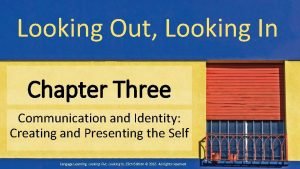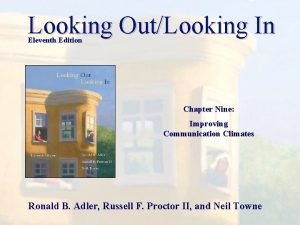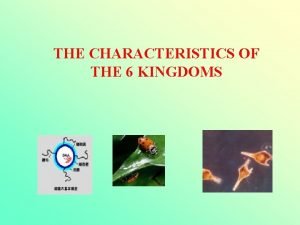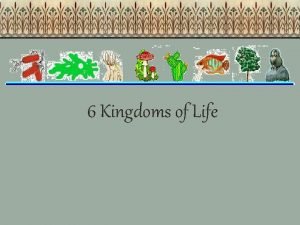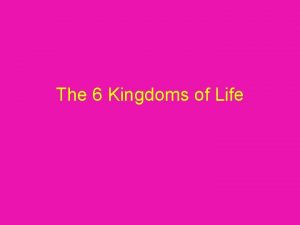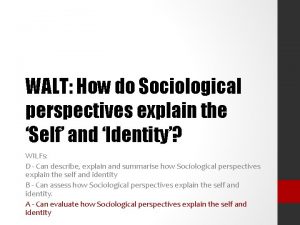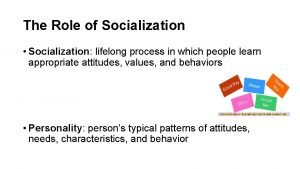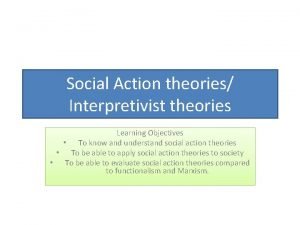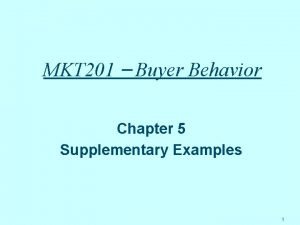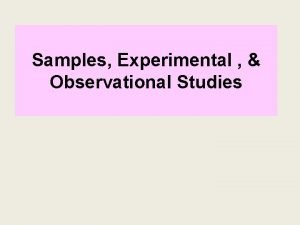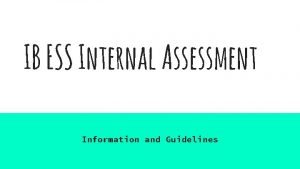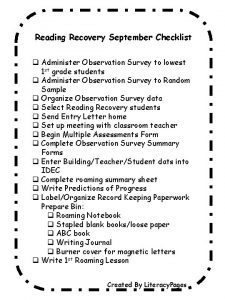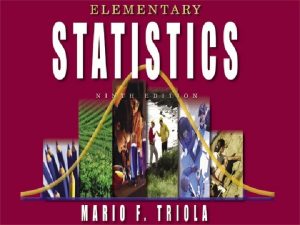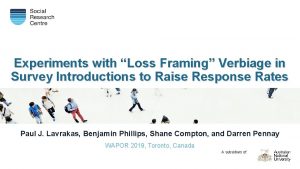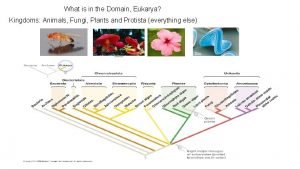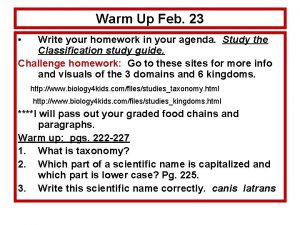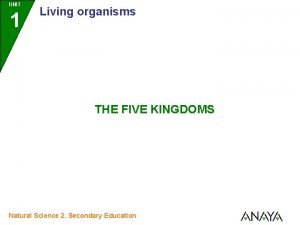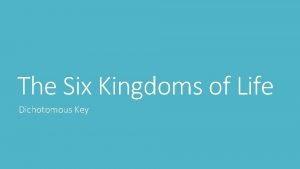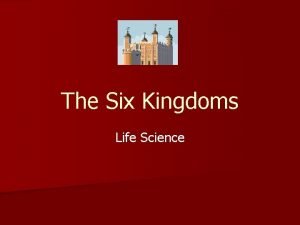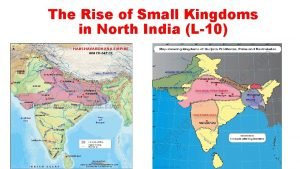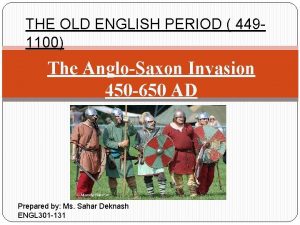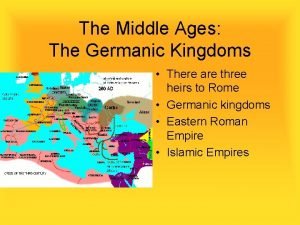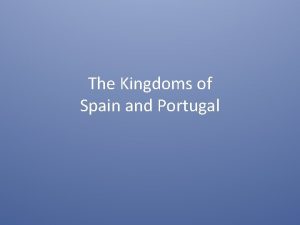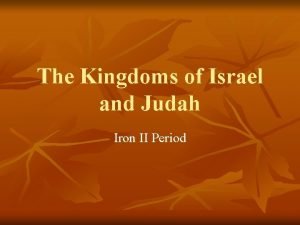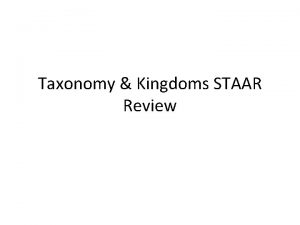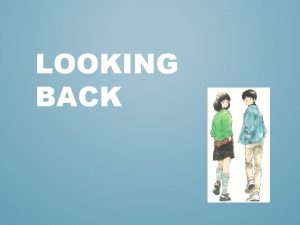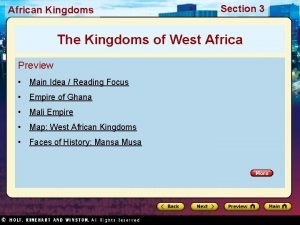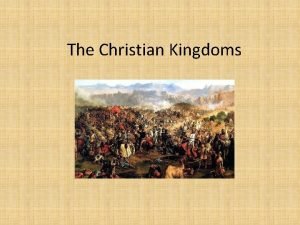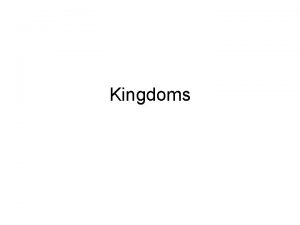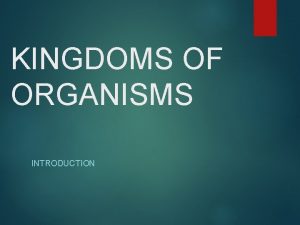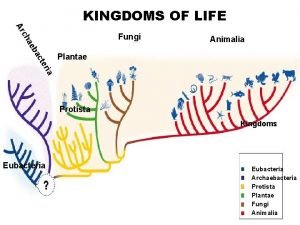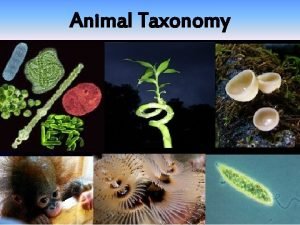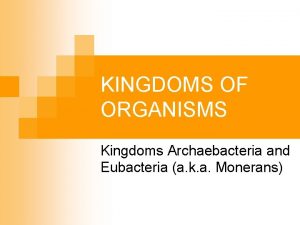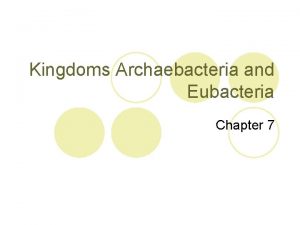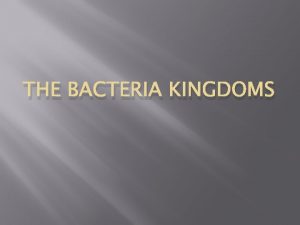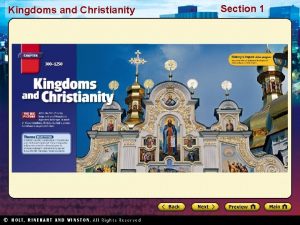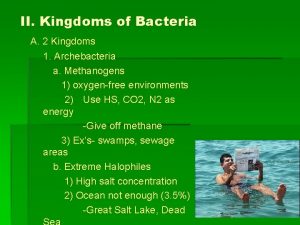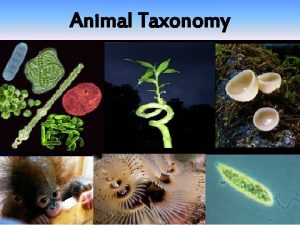SURVEY THROUGH THE KINGDOMS Looking at examples of













































































- Slides: 77

SURVEY THROUGH THE KINGDOMS Looking at examples of the life processe s in bacteria, protists, fungi, plants and animals

NUTRITION IN SIMPLE ORGANISMS Protists: Bacteria Exhibit all three modes of nutrition Exhibit both autotrophic and heterotrophic modes of nutrition. Use chemosynthesis: the production of carbohydrates through the use of energy from inorganic molecules. Bacteria are also decomposers—feeding on dead and decaying matter § Photosynthesis or autotrophy § Ingestion or heterotrophy § Absorption.

NUTRITION IN FUNGI Each phyla gets their nutrients in different ways: § Saprophytic/decomposers § Parasitic The fungi take in the nutrients after externally digesting the substance with enzymes and then absorbing those nutrients. These are crucial to cycling matter in the environment (carbon cycle).

NUTRITION IN PLANTS Use a process called photosynthesis to make their own food. § Plants, as well as a few protists (euglena/algae) and some bacteria make their own food by this above process. Autotrophic organisms have a special adaptation (specialized pigment) called, chlorophyll which allows them to capture the energy from the sun, converting this radiant energy into chemical energy, glucose.

NUTRITION IN ANIMALS Animals are heterotophic, which means that they must obtain food (complex organic molecules) from other sources. Most animals obtain this by ingestion--An animal taking in organic material. Digestion occurs within (ingestive) the animal’s body, and carbohydrates, lipids, amino acids, and other organic molecules are extracted from the material or cells.

NUTRITION IN ANIMALS Herbivores: Animals that eat mainly vegetation § Includes leaves, grass, flowers, seeds, roots, fruits, bark, pollen Carnivores: Animals that eat meat § Includes insects and all other animals. Omnivores: Animals that can eat both plants and animals

NUTRITION IN ANIMALS Detrivores: Animals that consumes or feeds on dead or decaying organisms or on the parts or wastes of other organisms.

ACTIVITY 1: FEEDING ADAPTATIONS Key Vocabulary—Use for the following slides : § § § § Autotroph Carnivore Heterotroph Herbivore Omnivore Producer Saprophytes Consumer Parasites Detrivore Decomposer Chemoheterotroph Chemoautotroph Photoheterotroph Ingestive Absorptive • Internally breaks down and absorbs nutrients • Uses enzymes to breakdown organism before obtaining nutrients Digestion

ACTIVITY 2 Write the chemical equation for photosynthesis:

ACTIVITY 3 1. Draw a carbon cycle. On your picture include the atmosphere, fungi on a bed of dead leaves, living plants and 1 animal or human. 2. Draw arrows to show the flow of carbon through the cycle. 3. Label on the picture where each of the following processes is occurring: eating, decomposition, cell respiration, photosynthesis. Color the autotrophs green and the heterotrophs blue.

ACTIVITY 4 1. List 4 herbivores and what they eat 2. List 4 carnivores and what they eat 3. List 4 ominvores and what they eat. 4. Of all the organisms brainstormed above, pick 5 that live in a similar environment (forest, ocean, jungle, etc) and create a food web/chain to illustrate who eats who. (see examples) Food chain Food web

ACTIVITY 5 Construct a 4 part Venn diagram comparing/contrast ing fungi, protists, plants and animals. Focus on the modes of nutrition Use vocabulary from the first slide of this section. Plant Protists Animal Fungi

ACTIVITY 6 1. Write the equation for cellular respiration 2. Where does this occur? 3. What type of organisms do this process?

RESPIRATION IN ORGANISMS ON LAND Many organisms have small respiratory systems with lungs. § Lungs are elastic, sponge-like organs that exchange gases between body tissues and the air. § Alveoli are tiny balloon-shaped sacs that diffuse the air from the lungs to the capillaries (simple diffusion) Carbon dioxide is returned to atmosphere through exhale

RESPIRATION IN ORGANISMS IN WATER Most aquatic animals use gills for respiration. § Gills: Specialized tissues containing blood vessels that take in oxygen dissolved in water § Fish take in water through their mouth, then the water flows over the fish’s gills and the blood vessels take the oxygen out of the water. (Diffusion) § At the same time, carbon dioxide in the blood vessels is released into water as it flows out. (Diffusion) § Can be difficult and water can have low levels of oxygen Unique gill adaptations: § Mollusks: Gills are located in central body cavity and water is pumped through there—Examples: Clams and mussels § Crustaceans: Gills are located on legs and as they walk, water moved over the gills—Examples: Lobsters and crabs

RESPIRATION IN AMPHIBIANS Amphibians spend part of their life completely under water and then the other part, they live in the water and on land. § Frogs live in the water as a tadpole (young) and eventually show complete metamorphosis and live in both places as an adult frog. § As a tadpole, they use gills and move to create movement of water past the lungs § As an adult, they create thin lungs that are connected to the mouth § Frogs also use their skin to diffuse gases into their body.

RESPIRATION USING SKIN Several animals exchange gases for respiration using their skin, like a frog § Organisms that use skin: § Are usually thick-skinned § Are fairly small § Skin must stay moist to exchange the gases Examples: § Earthworms (Annelids or segmented worms): Secrete mucus and live in moist soil to keep skin moist § Arthropods (insects, spiders, mites, centipedes): Exchange gases using tracheas, which deliver oxygen directly to tissues, and pick up carbon dioxide for removal § Tracheas lead to openings called spiracles, located on side of abdomen

TRANSPORT IN UNICELLULAR: BACTERIA, PROTISTS AND FUNGI Unicellular Organisms such as: § Bacteria (cyanobacteria, E. coli) § Protists (Amoeba, Paramecia, Euglena) § Fungi (yeasts) Small organisms do not require an internal transport system. § Diffusion/osmosis: Is what they use to get food and gases to their cell parts.

TRANSPORT IN SIMPLE MULTICELLULAR PLANTS & ANIMALS Examples: § Simple plants such as Bryophyta (mosses) § Simple animals such as Cnidarians (sea anemones) & Platyhelminthes or flatworms (planaria) These organisms (like unicellular organisms) have a LARGE surface area to volume ratio. § Surface area is large enough to allow all the gases to reach the cells by diffusion/osmosis § Once inside the cells, the distances to travel to other parts are small—so once again diffusion is sufficient.

TRANSPORT IN MULTICELLULAR PLANTS & ANIMALS The opposite occurs: § Most multicellular organisms that have tissues, organs and organ systems. § LARGE organisms have a SMALL surface area to volume ratio. § Most complex organisms have waxy cuticles, scales, skin, hair and or shells which are not semi-permeable to allow diffusion. § Therefore, there is a need for a transport system or circulatory system. § Diffusion is not fast enough to reach all cells to allow survival.

TRANSPORTED MATERIALS Transported materials: Useful: Oxygen, digested or manufactured food, water, mineral salts, hormones, antibodies, plasma proteins etc. Wastes: carbon dioxide, nitrogenous waste Harmful: alcohol, drugs Table 1 below shows examples of substances transported in blood of humans. Substance Transported from Transported to Why it needs to be transported Oxygen Digested foods (fats, glucose, amino acids) Urea and other nitrogenous waste Hormones Heat Lungs Digestive organs (intestinal villi) and liver Liver and body cells Body cells Respiration Growth and cell metabolism Kidneys Excretion Ductless endocrine glands Muscles, liver Various organs as needed All tissues Carbon dioxide Body cells and tissues Lungs Regulation of body functions Regulation of body temperature Excretion

TRANSPORT IN MULTICELLULAR PLANTS & ANIMALS Both transport systems in plants and animals use water as the basis for transport since it is: § A good solvent § Has a high specific heat (doesn’t change temperature easily) § Is not too viscous (thick) § Is unreactive (inert). Both animals and plants have more than one type of tissue which is specialized to make transport easier.

TRANSPORT ADAPTATIONS IN MULTICELLULAR PLANTS Plants have specialized tissues called Vascular Tissues: a. Xylem – tube-like cells that carry water and dissolved minerals such as nitrates and nitrites-UP/against gravity from the roots to the rest of the plant. b. Phloem – tube-like cells that carry carbohydrates such as glucose and sucrose – DOWN - from the leaves and other photosynthetic organs to the rest of the plant.

TRANSPORT IN SIMPLE MULTICELLULAR ANIMALS Some animals have a transport system that is “open”—Examples: Some Arthropods (insects & crustaceans) § An Open Circulatory System is one in which the fluids are not contained in vessels. Instead the fluids just “bath” the tissues and provide them with necessary gases and nutrients.

TRANSPORT ADAPTATIONS IN MULTICELLULAR ANIMALS In the circulatory system in mammals, such as humans, the blood vascular system is made up of: • Blood vessels: arteries, capillaries and veins. • Heart Mammals have a closed circulatory system i. e. blood circulates constantly from a pump through a series of tubes and back to the pump. § § Arteries carry blood away from heart Veins carry blood to heart

ACTIVITY 7 Cell Respiration Equation: ATP + 6 CO 2 + C 6 H 12 O 6 6 O 2 + 6 H 2 O *What’s wrong with that equation? Correct any mistakes made by rewriting it accurately! The Mitochondria Draw and label a mitochondria with the following parts: § Cristae § Matrix § Membrane

ACTIVITY 8 Not all animals with lungs live on land. Think of 1 organism that lives in the water that has lungs. 1. Name the organism 2. How do they exchange the gases? 3. Name one adaptation they must have in order to survive long periods of time underneath the water.

ACTIVITY 9 Lungs: Compare gills and lungs in a Venn Diagram. Include an Gills: example organism for each part of the diagram. Both gills and lungs Example: with example

ACTIVITY 10 Watch the short video clip at www. sasinschool. com § Login: hshshawks § QL #1275 After watching, answer the following questions: 1. What were the ancestors of land plants (where did they come from)? 2. Why are Non-tracheophytes (Bryophytes) such as mosses always found in moist, shady environments? 3. Tracheophytes such as ferns, pine trees and flowering plants compete for limited resources. Thus added size and growing taller was an adaptation to absorbing light. The added size and height of plants however caused what other problem?

ACTIVITY 11 Part 1: § Notice that the Moss is a small plant located close to the ground. They usually grow in moist, shady environments. Explain how mosses are able to transport water from cell to cell? Part 2: § Look at the celery that is in colored water. (use page 51) 1. What “action” of water is occurring here? (due to cohesion and adhesion) 2. Which vascular tissue transports water and minerals from the roots upward? 3. What is the name for the other vascular tissue that transports food such as glucose downward/throughout the plant?

ACTIVITY 12 Multicellular Animals often transport substances by either using a Closed or an Open Circulatory system. 1. What is the difference between these two systems? Fish have two chambered hearts, amphibians have three chambered hearts. 2. How many chambers are in a bird or mammal heart? (use pictures & heart model provided for help) 3. What is the name of the top chambers? The bottom chambers? 4. What is the job of the heart in transport?

ACTIVITY 13 The movement of materials in and out of the cell is a very important process. Fill in this table about cell transport. Type of Cell Transport Active Passive Is Energy 2+ Used? (y or Examples n) Extra Facts

EXCRETION Definition: The process by which organisms remove waste from their cells or bodies to maintain homeostasis. All organisms produce waste products, as a result of the chemical reactions they perform (metabolism). § Wastes include: § Water § Salts § Carbon dioxide § Nitrogenous wastes (contain nitrogen Some organisms have sophisticated organ systems for this process, others are very simple. Excretion is necessary in order to maintain the balance of p. H, water and salt. If an organism cannot rid itself of waste, it will die from toxicity.

EXCRETION Certain organisms, such as bacteria and fungi, remove waste products through the simple process of osmosis and diffusion. § These move substances from an area of high concentration to low concentration.

EXCRETION IN PROTISTS Protists such as amoeba and paramecium use contractile vacuoles along with diffusion to remove wastes. Ex: Amoeba paramecium

EXCRETION & RESPIRATION IN PLANTS Plants use their stoma to take in and remove gases & water. § The stoma are usually found on the underside of the leaves or in the case of cacti, on their stems.

EXCRETION IN INSECTS & SPIDERS Insects and spiders use malpighian tubules that are found in the blood-filled body of these organisms. § The wastes are filtered into the tubules by diffusion and active transport and released by the anus.

EXCRETION IN WORMS Worms use a special structure called the nephridia (excretory tubules)to excrete wastes and excess water. § The movement of the nephridia as it filters the wastes looks like a flickering flame and is often called a flame cell. § The waste is eliminated through pores on the body.

DIAGRAM OF NEPHRIDIA

EXCRETION IN CRUSTACEANS Crayfish and other crustaceans have two types of excretory organs: Gills and antennal glands. Gills excrete carbon dioxide and the antennal glands excrete water, salts and ammonia. They also use these to obtain oxygen through respiration.

EXCRETION IN VERTEBRATES There are 3 types of nitrogenous wastes in vertebrate animals: § Ammonia § Urea § Uric acid. All can be toxic. Vertebrate animals use kidneys to rid their system of nitrogenous wastes.

THE NEPHRON OF THE KIDNEY The kidney is made up of many functional units called nephrons. § There are 1 million nephrons in each adult human kidney § Their job is to filter the blood as it passes through the kidneys and collect it in the bladder for elimination.

OTHER EXCRETORY ORGANS Lungs: § Excrete carbon dioxide—a waste gas. Skin: § Excretes water, salts & urea.

ACTIVITY 14 Look at the slide of the stoma in the microscope. § Draw and label the stoma and guard cell. § Use arrows to show what gases enter and leave through the stoma.

ACTIVITY 15: Many aquatic animals such as crayfish have gills. 1. What are they used for? 2. What structures do other animals like ourselves use instead of gills for this purpose? 3. What is another process that uses the gills?

BACTERIA REPRODUCTION Binary fission: § Asexual reproduction that produces identical DNA for parent and new cell. *NO VARIATION Conjugation: § Sexual reproduction where 2 or more bacteria link pili together and exchange DNA fragments. Allows for genetic variation. Transformation: § DNA from environment is taken into bacterial cells and mixed with bacterial DNA. This, also, gives variation. When bacteria DNA changes by mutation, they become better suited to the environment and survive. Surviving bacteria reproduce. This is how bacteria become resistant to antibiotics

BACTERIAL REPRODUCTION

REPRODUCTION IN PROTIST Protists can reproduce by mitosis to produce an individual that is genetically identical to the parent. *NO VARIATION Fragmentation: § A piece of the parent breaks off to form a new, genetically identical individual. NO VARIATION! They can conjugate: § Sexual reproduction—This allows for DNA to be exchanged to give variation of the DNA in the population. Paramecium conjugation

PROTIST CONJUGATION: PARAMECIUM

REPRODUCTION IN FUNGI Fungi can bud: an asexual offspring growth from parent plant. § Genetically identical offspring to parent. NO VARIATION. Hyphae can join and combine DNA. § Sexual reproduction. § gives variation in the DNA. Spores are produced by fungi. § 1 n: Spores must join to form a zygote. § 2 n: spores need to germinate in a moist area. Fungi reproduce using ATP energy made during cell respiration.

REPRODUCTION IN PLANTS Can asexually reproduce: • Fragmenting • Cuttings • Grafting Can sexually reproduce: • 4 phyla of plants: • Bryophytes (mosses) & Ferns • Reproduce with spores • Gymnosperms • Reproduce with cones seeds • Angiosperms. • Reproduce with flowers seeds

REPRODUCTION USING SEEDS § Germination (seed growth) occurs when gymnosperms and angiosperms are in favorable conditions § Seeds and spores are produced by sexual reproduction. § Seed plants produce pollen and eggs that join to make a zygote § Flower: the reproductive organ of an angiosperm plant § Methods of seed dispersal: § Wind § Water § Animals

REPRODUCTION IN ANGIOSPERMS FLOWERS

REPRODUCTION IN ANIMALS Classified into 9 phyla in the Animal Kingdom Can be done asexually—reproduce by fragmenting or budding § Example: Sponges—Phyla Cnidarian Can be done sexually—reproduce using sperm and egg § Aquatic animals release sperm into the water and swim to the egg. § Terrestrial animals, external or internal fertilization can occur.

REPRODUCTION IN ANIMALS GESTATION IN SHELLS Turtle/Reptile Eggs hard shelled Frog Eggs Soft shelled Clumped in mucus Bird Eggs hard shelled

ACTIVITY 16 Asexual Reproduction Sexual Reproduction 1. Describe asexual 4. Describe sexual reproduction. 2. What is the end result 5. What is the end result of this process? 3. Recall one example 6. Recall one example of of a living thing that does this process. *Use the Coach book as a reference

ACTIVITY 17 1. Look at the seeds. How is each dispersed? 2. How is the dispersing of seeds good for the survival of the species?

ACTIVITY 17 3. Look at the fern under the dissecting scope. § What are the round clusters on the bottom of the leaf?

ACTIVITY 18 Use Coach book and station information to answer the following questions: 1. Which of the following are NOT reproductive structures in flowering plants? A. B. C. D. 2. Which of the statements describes an advantage of asexual reproduction over sexual reproduction? A. B. C. D. 3. Stamens Cones Ovaries Seeds Asexual reproduction requires the presence of other members of the species Asexual reproduction is best suited for rapidly changing environments Asexual reproduction increases the variety of traits in an organisms offspring Asexual reproduction takes less time and usually produces more offspring The eggs laid by frogs and other water animals often lack a hard outer covering. The eggs laid by land animals are generally surrounded by a hard outer shell. What are the benefits of a hard outer shell for the eggs of land animals?

DEVELOPMENT ON A CELLULAR LEVEL Remember…stem cells are important to the development process: § Stem cells: Undifferentiated cells that will be specialized into a specific type of cell with specific structure/function. (multi-cellular organisms)

GROWTH & DEVELOPMENT IN BACTERIA Grow and develop during the G 1 and G 2 phases of the cell cycle. Energy for growth/development comes from ATP (made from cell respiration. § Done in the cytoplasm, using the cell membrane for the ETC (last stage). § Start out smaller, create proteins for structure. § The picture shows one adult bacteria and 2 juvenile bacteria. NOTICE the circular DNA and no organelles.

GROWTH & DEVELOPMENT IN PROTIST Growth Developme nt 1 st eukaryotic cells, Juvenile formed from protist endosymbiosis generates proteins Endosymbiosis picture: for growth after mitosis (using ATP) Picture of an adult & juvenile protists:

GROWTH & DEVELOPMENT IN FUNGI Root-looking hyphae form under the surface. § Grow by mitosis § Emit enzymes for fungal food source. § Digests foods externally then absorbs it. Above: Fungal hyphae growing in a petri dish. Note: they grows in circles!

GROWTH & DEVELOPMENT IN PLANTS Plants grow by mitosis Cells then specialize and group into tissues and organs § These tissues & organs have specific jobs § Leaves= photosynthesis § Stem= transport and support § Roots= absorb water, anchor plant § Flower= reproduction Once developed, it can then reproduce & continue to grow. § Requires resources to survive: § Sunlight, water and CO 2 for photosynthesis

GROWTH & DEVELOPMENT IN PLANTS Hormones that control growth are called auxins § Gravitropism- stem grows upward, roots grow downward § Phototropism- growing toward the light source § Thigmotropism-growing to the touch

GROWTH & DEVELOPMENT IN ANIMALS Animals grow by mitosis § Cells specialize into groups of tissues and organs. As the zygote continues to grow, development occurs and the cells begin to specialize. § This specialization was an adaptation that allowed the original organism to adapt better to the environment. § Some specialized organs include stomach, brain, heart § It reproduces to make more organisms with this adaptation. Energy needed for growth (ATP) § Animals are heterotrophs so the food energy comes from eating.

GROWTH & DEVELOPMENT IN MAMMALS Mammals are highly specialized animals and have three unique ways of developing before birth: § Marsupial: A “joey” develops in uterus for a short time (4 -5 weeks) then as a blind, furless newborn the size of a jellybean climbs across mother to feed then goes into a pouch, where it continues to develop for as much as a year. § Monotreme: These mammals lay eggs instead of giving live birth § Placental mammal: Mammals develops in uterus and are born live

GROWTH & DEVELOPMENT IN ANIMALS Symmetry and body cavities created during development are used to classify organisms in the 9 phyla of the animal kingdom.

METAMORPHOSIS IN ANIMALS Incomplete Metamorphosis: 3 stages of life Egg-nymph-adult Nymph is just a smaller version of the adult Complete Metamorphosis: 4 stages of life Egg-larvae-pupa-adult Larva: in different form from adult—eats a ton! Pupa: seemingly lifeless-a time for change

ACTIVITY 19 1. Look at the adult and juvenile paramecium (before and after mitosis) picture. How are they different? Compare the two. 2. Look at the mushroom under the dissecting scope. Can you see the hyphae (thread looking structures that make up the cap)? Name 2 functions of this structure. 3. Look at the plant. Does it appear to have gravitropism, thigmotropism, or phototropism? Define each plant behavior.


ACTIVITY 20 Using the information provided and a computer, answer the following questions: 1. Differentiate between the three ways a mammal develops, placental(Eutherian), marsupial and monotreme. 2. Brainstorm 1 example of each type of animal. 3. A. Using the phylogenetic tree provided, what was the earliest type of mammal to evolve? B. Which evolved the most recently? C. What do you think is the evolutionary advantage of developing in a placenta?


ACTIVITY 21 Incomplete Metamorphosis: 3 stages of life Egg-nymph-adult Nymph is just a smaller version of the adult Complete Metamorphosis: 4 stages of life Egg-larvae-pupa-adult Larva: in different form from adult— eats a ton! Pupa: seemingly lifeless-a time for change 1. Anal yze the two insects g oi ng through metamorphosis i n the picture to the right. § Explain 2 similarities and 2 differences between incomplete and complete metamorphosis.



 Looking out/looking in
Looking out/looking in Looking out looking in chapter 9
Looking out looking in chapter 9 Abcd atls
Abcd atls Walk through survey
Walk through survey Wolf kingdom classification
Wolf kingdom classification What are the six classifications of living things on earth
What are the six classifications of living things on earth 3 domains and 6 kingdoms chart
3 domains and 6 kingdoms chart The 6 kingdoms of life
The 6 kingdoms of life Front stage vs backstage self
Front stage vs backstage self The looking glass self examples
The looking glass self examples Strengths and weaknesses of social action theory
Strengths and weaknesses of social action theory Looking glass self examples
Looking glass self examples Through one man sin entered
Through one man sin entered Furcation classification
Furcation classification Through and through sawing advantages and disadvantages
Through and through sawing advantages and disadvantages Night of scorpion summary
Night of scorpion summary Hát kết hợp bộ gõ cơ thể
Hát kết hợp bộ gõ cơ thể Bổ thể
Bổ thể Tỉ lệ cơ thể trẻ em
Tỉ lệ cơ thể trẻ em Voi kéo gỗ như thế nào
Voi kéo gỗ như thế nào Glasgow thang điểm
Glasgow thang điểm Hát lên người ơi alleluia
Hát lên người ơi alleluia Môn thể thao bắt đầu bằng chữ đua
Môn thể thao bắt đầu bằng chữ đua Thế nào là hệ số cao nhất
Thế nào là hệ số cao nhất Các châu lục và đại dương trên thế giới
Các châu lục và đại dương trên thế giới Công thức tính độ biến thiên đông lượng
Công thức tính độ biến thiên đông lượng Trời xanh đây là của chúng ta thể thơ
Trời xanh đây là của chúng ta thể thơ Cách giải mật thư tọa độ
Cách giải mật thư tọa độ Phép trừ bù
Phép trừ bù Phản ứng thế ankan
Phản ứng thế ankan Các châu lục và đại dương trên thế giới
Các châu lục và đại dương trên thế giới Thể thơ truyền thống
Thể thơ truyền thống Quá trình desamine hóa có thể tạo ra
Quá trình desamine hóa có thể tạo ra Một số thể thơ truyền thống
Một số thể thơ truyền thống Cái miệng nó xinh thế chỉ nói điều hay thôi
Cái miệng nó xinh thế chỉ nói điều hay thôi Vẽ hình chiếu vuông góc của vật thể sau
Vẽ hình chiếu vuông góc của vật thể sau Nguyên nhân của sự mỏi cơ sinh 8
Nguyên nhân của sự mỏi cơ sinh 8 đặc điểm cơ thể của người tối cổ
đặc điểm cơ thể của người tối cổ V. c c
V. c c Vẽ hình chiếu đứng bằng cạnh của vật thể
Vẽ hình chiếu đứng bằng cạnh của vật thể Tia chieu sa te
Tia chieu sa te Thẻ vin
Thẻ vin đại từ thay thế
đại từ thay thế điện thế nghỉ
điện thế nghỉ Tư thế ngồi viết
Tư thế ngồi viết Diễn thế sinh thái là
Diễn thế sinh thái là Các loại đột biến cấu trúc nhiễm sắc thể
Các loại đột biến cấu trúc nhiễm sắc thể Số nguyên tố là
Số nguyên tố là Tư thế ngồi viết
Tư thế ngồi viết Lời thề hippocrates
Lời thề hippocrates Thiếu nhi thế giới liên hoan
Thiếu nhi thế giới liên hoan ưu thế lai là gì
ưu thế lai là gì Khi nào hổ mẹ dạy hổ con săn mồi
Khi nào hổ mẹ dạy hổ con săn mồi Sự nuôi và dạy con của hổ
Sự nuôi và dạy con của hổ Hệ hô hấp
Hệ hô hấp Từ ngữ thể hiện lòng nhân hậu
Từ ngữ thể hiện lòng nhân hậu Thế nào là mạng điện lắp đặt kiểu nổi
Thế nào là mạng điện lắp đặt kiểu nổi Observational study examples statistics
Observational study examples statistics Observational survey examples
Observational survey examples Survey objectives examples
Survey objectives examples Ess ia word limit
Ess ia word limit Predictions of progress reading recovery examples
Predictions of progress reading recovery examples Survey hypothesis examples
Survey hypothesis examples Examples of survey introductions
Examples of survey introductions Domain eukarya
Domain eukarya Mansa musa temple
Mansa musa temple Flow chart of domains and kingdoms
Flow chart of domains and kingdoms Example of kingdoms
Example of kingdoms 6 kingdoms
6 kingdoms Dichotomous key kingdoms
Dichotomous key kingdoms Archaebacteria body type
Archaebacteria body type The kingdoms of pratiharas and palas rose in north india
The kingdoms of pratiharas and palas rose in north india Old english kingdoms map
Old english kingdoms map Germanic kingdom
Germanic kingdom Four kingdoms of spain
Four kingdoms of spain Kingdoms of israel and judah
Kingdoms of israel and judah What are the kingdoms in biology
What are the kingdoms in biology
